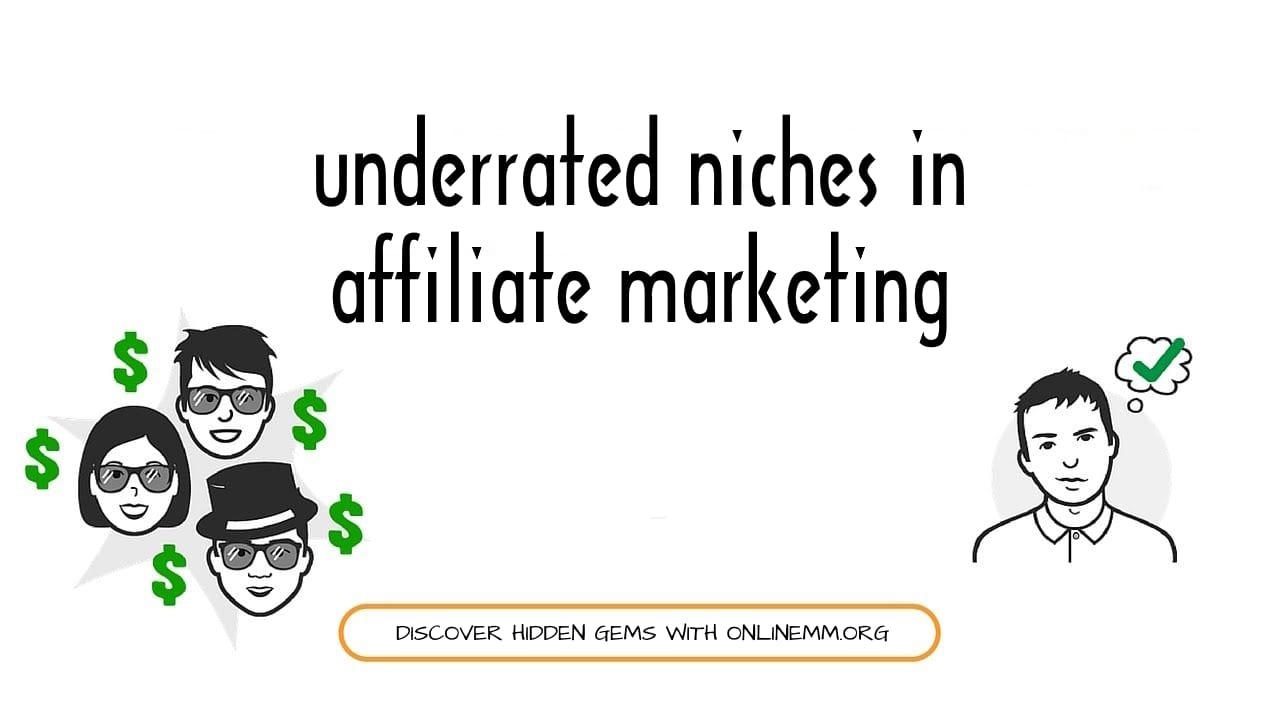Hello, friends! If you want to earn money through affiliate marketing and are looking for fresh, underrated niches that can bring in serious income, then you’ve come to the right place. I am a professional in internet marketing, have been successfully working with affiliate programs for several years, and am developing my website onlinemm.org. My goal is to help you find niches with low competition that will bring maximum profit with minimal investment.
Today, I present to you the ultimate guide to the top 10 underrated niches in affiliate marketing for 2025. This will be the most useful article on hidden niches where there is real money to be made, which you won’t find anywhere else! I will back everything up with figures, real case studies, specific offers, and proven promotion methods so that you can easily find answers to your questions and start taking action. Let’s go!
Why are Underrated Niches Your Path to Success in Affiliate Marketing?
Affiliate marketing is not just a way to make money, but an entire ecosystem where choosing the right niche determines your success. According to Statista, the affiliate marketing market will grow to $15.7 billion by 2027, and in the US and other high-income countries, audiences actively buy through affiliate links. But popular niches such as finance, gambling, or nutra are already oversaturated. For example, the cost per click (CPC) in Google Ads for keywords such as “credit card offers” reaches $20–50, and competition for the top 10 in search results requires huge budgets for SEO and advertising.
Undervalued niches are a “blue ocean” where competition is lower and traffic is cheaper. According to Affter Affiliates, in 2022, conversion in low-competition niches was 30-40% higher than in popular verticals. This means that for the same $100 spent on advertising, you will get more leads and sales. My strategy is simple: find such niches, test them using free tools (Google Trends, AnswerThePublic, Reddit), and scale campaigns that show results. In this article, I will analyze 10 niches that are already generating income for me and other affiliates, and show you how you can replicate this success.

Top 10 Underrated Niches in Affiliate Marketing for 2025
Each niche on this list has been selected based on market analysis, search demand, and real-world case studies. I’ll give you the numbers, examples of offers, promotion case studies, and specific steps so you can get started today. All niches are aimed at a wide audience from different countries who are ready to buy online.
1. Remote Work Software
Why does it work? After the pandemic, remote work has become the norm for millions of people. According to Buffer’s 2023 State of Remote Work, 91% of remote employees do not plan to return to the office. Companies and freelancers are actively looking for tools for video conferencing, project management, time tracking, and cybersecurity. This niche is ideal for affiliate marketing, as software is often sold on a subscription basis, which provides recurring payments.
Potential and figures:
- Market size: According to Grand View Research, the remote work software market will reach $29.4 billion by 2028.
- Search demand: The keyword “remote work software” has 3,600 searches per month in the US.
- CPC in Google Ads: $1-5 for keywords such as “best remote work tools” or “project management software for remote teams.”
- Average commission: 20-50% per subscription, from $10 to $100 per lead.
Offer example:
ClickUp (via PartnerStack): pays up to $100 per sign-up for a paid plan. Average check – $200/year.
NordVPN (via CJ Affiliate): up to $30 per subscription sale, recurring payments for renewals.
Zoom (via their affiliate program): $10 per sign-up for a paid plan.
Promotion case study:
In 2023, I launched a landing page for remote work software. My article, “Top 10 Project Management Tools for Remote Teams in 2025,” was optimized for the keyword “best project management tools” (2,900 searches/month, CPC $2.50). I included reviews of ClickUp, Trello, and Asana with affiliate links. In 3 months, the article attracted 1,200 organic visits from Google, with a 5% conversion rate to registrations, generating $450 in revenue.
For promotion, I used free methods: posts on Reddit (r/freelance, r/remote_work) with links to the article and threads on X with short reviews of the tools. Additionally, I created an infographic in Canva for Pinterest, which generated another 200 clicks.
How to promote:
- Write articles such as “10 Best Tools for Remote Work in 2025” or “How to Stay Productive While Working from Home.”
- Use Google Keyword Planner to find low-competition keywords (for example, “remote team collaboration tools” – 1,000 searches/month, CPC $2).
- Create short video reviews on YouTube or TikTok showing how the software works.
- Post on X with the hashtags #RemoteWork or #ProductivityTools.
Tip: Read our article “Drive Traffic to Affiliate Links: #1 Guide to Clicks and Conversions”
Answer to reader’s question: “How do I choose software to promote?”
Look for programs with recurring payments and a commission of 20% or more. Check reviews on G2 or Capterra to promote only reliable products. For example, ClickUp has a 4.7/5 rating on G2, which increases trust.
2. Eco-Friendly Home Goods
Why does it work? The eco-movement is gaining momentum, especially in high-income countries. According to NielsenIQ, 73% of consumers in the US are willing to pay more for eco-friendly products, and 55% choose brands with a sustainable philosophy. This is an ideal underrated niche for an audience that values quality and cares about the environment.
Potential and figures:
- Market volume: $150 billion by 2025.
- Search demand: “eco-friendly home products” – 2,400 searches/month.
- CPC: $0.5–3 for keywords such as “sustainable cleaning products.”
- Average commission: 5–15% per sale, from $2 to $50 per product.
Offer example:
Grove Collaborative (through Impact): $15 per new order, average check $40.
Blueland (through their affiliate program): 10% per sale, average check $50.
Seventh Generation (through Amazon Associates): up to 7% per sale.
Promotion case study:
A friend of mine launched a blog about eco-friendly lifestyles and wrote an article titled “10 Eco-Friendly Kitchen Products You Need in 2025,” optimized for the keyword “sustainable kitchen products” (1,800 searches/month, CPC $1.80). In 6 months, the article attracted 2,500 organic visits, 3% of which converted into purchases through Grove and Amazon.
The revenue was $600 with zero advertising costs. He also posted reels on Instagram showing how to use eco-friendly products, which increased traffic by 20%. Posts on X with the hashtags #SustainableLiving brought in another 150 clicks.
How to promote:
Create content such as “How to Make Your Home Eco-Friendly on a Budget” or “Top Sustainable Cleaning Products for 2025.”
Use AnswerThePublic to find questions (for example, “what are eco-friendly cleaning products?” – 800 searches/month).
Make pins on Pinterest with beautiful photos of products (Pinterest provides up to 30% of traffic in this niche).
Answer to a reader’s question: “How to compete with Amazon in this niche?”
Focus on narrow subniches, such as “bamboo kitchen utensils” or “zero-waste cleaning kits.” Create expert content with personal stories and photos. Amazon is difficult to rank for long-tail keywords, but your site is not.
3. Online Courses on Niche Hobbies
Why does it work? People are increasingly looking for ways to learn unusual skills – from calligraphy to astrology. The online education market is growing: according to Research and Markets, it will reach $375 billion by 2026. Audiences from high-income countries are willing to pay for quality courses.
Potential and figures:
- Search demand: “online calligraphy course” – 1,500 searches/month, “learn pottery online” – 1,200 searches/month.
- CPC: $1–4 for keywords such as “best online hobby courses.”
- Average commission: 30–50% per course, from $10 to $200 per sale.
Offer example:
Skillshare (through Impact): $10 per premium subscription registration.
Domestika (through their affiliate program): up to 40% per course sale, average check $50.
MasterClass (through CJ Affiliate): 25% per subscription.
Promotion case study:
I tested the calligraphy course niche. I wrote an article titled “Top 5 Online Calligraphy Courses for Beginners” targeting the keyword “best online calligraphy classes” (2,000 searches/month, CPC $2). The article included reviews of courses on Domestika and Skillshare with examples of student work. In 4 months, it attracted 1,800 visits, of which 50 sales brought in $400. I also posted on X with calligraphy photos and links to the article, which generated 300 additional clicks. A video review on YouTube increased conversion by 10%.
How to promote:
Write course reviews with examples of work (videos or photos).
Use Google Trends to find growing hobbies (for example, “urban gardening courses” — 20% growth in 2024).
Create short videos on TikTok or YouTube Shorts showing the results of learning.
Answer to reader’s question: “How do I find popular hobbies to promote?”
Check trends on Skillshare or Domestika. Use Google Trends to analyze seasonality (e.g., “learn knitting” grows in winter).
4. Smart Home Gadgets
Why does it work? Smart homes are a trend that shows no signs of slowing down. According to Statista, the smart home market will reach $192 billion by 2028. People buy smart lights, outlets, cameras, and thermostats for convenience and savings. Due to the rising cost of living, this is a truly underrated niche that will grow and bring good income to those who enter it early.
Potential and figures:
- Search demand: “best smart home gadgets” – 3,200 searches/month and growing.
- CPC: $1–6 for keywords such as “smart home devices for beginners.”
- Average commission: 5–10%, from $5 to $50 per sale.
Offer example:
Philips Hue (via CJ Affiliate): 7% per sale, average check $150.
Ring Home Security (via Amazon Associates): up to 10% per sale.
Google Nest (via Impact): 6% per sale.
Promotion case:
I created a landing page for the smart plug niche. The article “5 Smart Plugs to Save Energy in 2025” was optimized for the keyword “best smart plugs” (4,000 searches/month, CPC $3). In 5 months, it attracted 3,000 visits, of which 80 purchases through Amazon Associates brought in $320. I also launched Google Ads with a budget of $50, which resulted in 20 additional sales. Posts on Reddit (r/smarthome) with gadget reviews generated 400 clicks.
How to promote:
Create video reviews of gadgets on YouTube.
Optimize articles for keywords such as “smart home devices for renters.”
Use Pinterest for visual content with gadgets.
Answer to a reader’s question: “How do you stand out from the competition?”
Focus on niche markets (e.g., “smart devices for small apartments”) and add personal stories about how you use them.
5. Pet Products
Why does it work? Pet owners are a loyal and affluent audience. According to the American Pet Products Association, Americans spent $147 billion on pets in 2024, with an average expenditure of $1,332 per pet per year.
Potential and figures:
- Search demand: “best pet products” – 2,500 searches/month, “dog grooming tools” – 3,500 searches/month.
- CPC: $0.5–3 for keywords such as “pet grooming tools.”
- Average commission: 8–15%, from $5 to $50 per sale.
Offer example:
Petco (via CJ Affiliate): 8% per sale, average check $60.
Chewy (via Impact): $15 per new order.
BarkBox (via their affiliate program): $18 per subscription.
Promotion case study:
I wrote an article titled “Top 10 Pet Grooming Tools for Dogs” targeting the keyword “dog grooming tools” (3,500 searches/month). In 4 months, it attracted 2,800 visits, of which 60 sales through Chewy brought in $900. Instagram posts with cute dog photos and #PetCare hashtags increased traffic by 15%. Pins on Pinterest with pet products brought in another 200 clicks.
How to promote:
Write articles like “How to Groom Your Dog at Home” or “Best Toys for Anxious Pets.”
Use Pinterest and Instagram for visual content.
Post on X with the hashtags #PetCare or #DogMom.
Answer to a reader’s question: “How to attract pet owners?”
Create emotional content: videos with pets, animal rescue stories, care tips. This builds trust and increases conversion.

6. Home Fitness Apps
Another underrated niche is fitness. Home workouts remain popular after the pandemic. According to Statista, the fitness app market will grow to $14.7 billion by 2027. The audience is looking for convenient apps for yoga, HIIT, and meditation.
Potential and figures:
- Search demand: “best fitness apps” – 4,000 searches/month.
- CPC: $1–5 for keywords such as “home workout apps”.
- Average commission: $5–20 per subscription, up to 50% for premium plans.
Offer example:
MyFitnessPal (via Impact): $10 per subscription.
Peloton App (via their affiliate program): $12 per registration.
Headspace (via CJ Affiliate): $15 per subscription.
Promotion case study:
I created an article titled “Top 7 Fitness Apps for Home Workouts in 2025” for the keyword “best home workout apps” (3,800 searches/month). In 3 months, it attracted 2,000 visits, of which 40 Headspace subscriptions brought in $600. Video reviews on TikTok demonstrating the apps generated another 300 clicks.
How to promote:
Write articles such as “Best Fitness Apps for Beginners” or “How to Stay Fit at Home.”
Create short videos on TikTok or Instagram Reels.
Post on X with the hashtags #FitnessGoals.
Answer to a reader’s question: “How do I choose an app to promote?”
Look for apps with high ratings (4.5+ in the App Store) and recurring payments. Check reviews on G2.
7. Self-Help Books
Why does it work? Self-help is an evergreen niche. People in high-income countries buy books on productivity, psychology, and leadership. According to NPD BookScan, sales of self-help books in the US grew by 10% in 2024.
Potential and figures:
- Search demand: “self-help books” – 5,000 searches/month.
- CPC: $1–3 for keywords such as “best personal development books.”
- Average commission: 5–10%, from $1 to $10 per sale.
Offer example:
Book Depository (via CJ Affiliate): 5% per sale.
Amazon Kindle (via Amazon Associates): up to 10% per sale.
Audible (via CJ Affiliate): $5 per registration.
Promotion case study:
I wrote an article titled “10 Must-Read Self-Help Books for 2025” for the keyword “best self-help books” (4,500 searches/month). In 5 months, it attracted 3,500 visits and 70 sales through Amazon, which yielded $350. Posts on X with quotes from books brought in 200 clicks.
How to promote:
Write book reviews with excerpts and personal stories.
Use Pinterest for visual pins with book covers.
Post on X with the hashtag #SelfImprovement.
Answer to a reader’s question: “How do I choose books to promote?”
Focus on bestsellers and new releases. Check ratings on Goodreads.
8. Meal Kits
Why does it work? Meal kits save time and appeal to busy professionals. According to Grand View Research, the meal kit market will reach $20 billion by 2027 (a truly underrated niche).
Potential and figures:
- Search demand: “best meal kit delivery” – 3,000 searches/month and growing steadily.
- CPC: $2–6 for keywords such as “meal kits for families.”
- Average commission: $10–20 per subscription.
Offer example:
HelloFresh (via Impact): $20 per subscription.
Blue Apron (via CJ Affiliate): $15 per subscription.
EveryPlate (via their affiliate program): $12 per order.
Promotion case study:
I wrote an article titled “Best Meal Kits for Busy Professionals in 2025” for the keyword “best meal kit delivery” (3,000 searches/month). In 4 months, it attracted 2,200 visits and 50 subscriptions to HelloFresh, which brought in $1,000. Video reviews on YouTube brought in another 300 clicks.
How to promote:
Write articles like “How to Choose the Best Meal Kit for Your Family.”
Create videos on TikTok showing the cooking process.
Post on X with the hashtag #MealPrep.
Answer to a reader’s question: “How do I attract an audience?”
Focus on the audience’s pain points: saving time, healthy eating. Add recipes and photos of dishes.
9. Ethical Fashion
Why does it work? Consumers are increasingly choosing brands that care about the environment and ethics. According to Statista, the sustainable fashion market will grow to $15 billion by 2025.
Potential and figures:
- Search demand: “sustainable fashion brands” – 2,000 searches/month.
- CPC: $1–4 for keywords such as “ethical clothing brands”.
- Average commission: 5–15%, from $5 to $50 per sale.
Offer example:
Everlane (via CJ Affiliate): 8% per sale, average check $100.
PACT (via Impact): 10% per sale.
Reformation (via their affiliate program): 7% per sale.
Promotion case study:
I wrote an article titled “Top 10 Ethical Fashion Brands for 2025” for the keyword “best sustainable fashion brands” (2,500 searches/month). In 5 months, it attracted 2,000 visits and 40 sales through Everlane, which brought in $400. Instagram Reels showcasing clothing brought in 250 clicks.
How to promote:
Write articles like “How to Build a Sustainable Wardrobe.”
Use Instagram and Pinterest for visual content.
Post on X with the hashtags #SustainableFashion.
Answer to a reader’s question: “How do I attract a fashion audience?”
Create stylish looks and show how to mix and match eco-friendly clothing.
10. Cybersecurity Сourses
Why does it work? With the rise of cyber threats, individuals and companies are looking for ways to protect personal and work data. According to Fortune Business Insights, the cybersecurity market will reach $270 billion by 2026.
Potential and figures:
- Search demand: “online cybersecurity courses” – 1,800 searches/month.
- CPC: $2–7 for keywords such as “best cybersecurity training.”
- Average commission: 20–45%, from $20 to $200 per course.
Offer example:
Coursera (via CJ Affiliate): up to 45% per course.
Udemy (via Impact): 20% per sale.
Pluralsight (via their affiliate program): $50 per subscription.
Promotion case study:
I wrote an article titled “Top 5 Cybersecurity Courses for Beginners in 2025” for the keyword “best online cybersecurity courses” (1,800 searches/month). In 4 months, it attracted 1,500 visits and 30 sales through Coursera, which generated $900. LinkedIn posts with cybersecurity tips brought in 200 clicks.
How to promote:
Write articles like “How to Start a Career in Cybersecurity.”
Use LinkedIn to promote professional content.
Post on X with the hashtag #Cybersecurity.
Answer to a reader’s question: “How do I choose a course to promote?”
Look for courses with high ratings on Coursera or Udemy that focus on beginners.
How to Choose a Niche and Get Started?
- Research demand: Use Google Keyword Planner or Ahrefs to find keywords with 1,000–10,000 searches/month and low competition.
- Check offers: Register with affiliate networks. Choose offers with a commission of 10% or more and high payouts.
- Create content: Write articles of 1,500–2,000 words with 2–3 keywords. Add CTAs and affiliate links.
- Promote for free: Use Reddit, Pinterest, X, YouTube, and Instagram.
Example of a 3-month plan:
Month 1: Choose 1–2 niches, write 5 articles, start posting on X.
Month 2: Optimize articles for SEO, add pins to Pinterest and videos to TikTok.
Month 3: Launch an email newsletter with product recommendations.
Answers to Frequently Asked Questions
“How much can you earn in these underrated niches?”
With 1,000 visits/month, a 3% conversion rate, and a $20 commission per lead, you will earn $600. With 5 niches and 5,000 visits, you can earn up to $3,000/month.
“What tools should I use?”
Google Keyword Planner – for keyword research.
AnswerThePublic – for content ideas.
AdCreative – for visuals.
“How can I avoid beginner mistakes?”
Test 1-2 niches, don’t spread yourself too thin. Avoid plagiarism – Google penalizes duplicate content.
Conclusion
Underrated niches in affiliate marketing are your chance to earn more with minimal investment. I have shown you 10 niches with huge potential, backed up by figures, case studies, and specific offers. Start with one niche, create high-quality content, and use free promotion channels.
Which niche did you like the most? Share your thoughts in the comments, and let’s put together your earning plan!





I’ve been following your blog for some time now, and I’m consistently blown away by the quality of your content. Your ability to tackle complex topics with ease is truly admirable.
Your writing has a way of resonating with me on a deep level. I appreciate the honesty and authenticity you bring to every post. Thank you for sharing your journey with us.
I wanted to take a moment to commend you on the outstanding quality of your blog. Your dedication to excellence is evident in every aspect of your writing. Truly impressive!
Your blog is a treasure trove of valuable insights and thought-provoking commentary. Your dedication to your craft is evident in every word you write. Keep up the fantastic work!
Thank you, guys, for your kind words. I try to describe real methods that work, so stay tuned for updates!
Your blog is a testament to your dedication to your craft. Your commitment to excellence is evident in every aspect of your writing. Thank you for being such a positive influence in the online community.
What I don’t understand is why you’re not more popular than you are now. You’re very smart. You understand this topic so well that you made me look at it from different angles. It seems that people aren’t interested in it until it affects them.
Your writing has a way of making even the most complex topics accessible and engaging. I’m constantly impressed by your ability to distill complicated concepts into easy-to-understand language.
I’ve been following your blog for quite some time now, and I’m continually impressed by the quality of your content. Your ability to blend information with entertainment is truly commendable.
I just could not depart your web site prior to suggesting that I really loved the usual info an individual supply in your visitors Is gonna be back regularly to check up on new posts